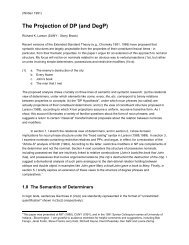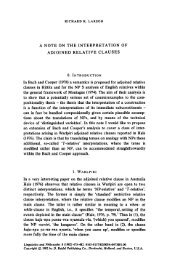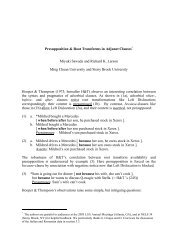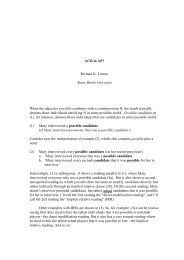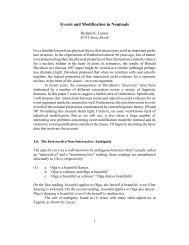Intensional Transitive Verbs and Abstract Clausal Complementation
Intensional Transitive Verbs and Abstract Clausal Complementation
Intensional Transitive Verbs and Abstract Clausal Complementation
Create successful ePaper yourself
Turn your PDF publications into a flip-book with our unique Google optimized e-Paper software.
<strong>Intensional</strong> <strong>Transitive</strong> <strong>Verbs</strong> <strong>and</strong> <strong>Abstract</strong> <strong>Clausal</strong> <strong>Complementation</strong><br />
Adverbial Ambiguity. The analysis accounts the familiar adverbial ambiguity in examples like (44a) in a<br />
straightforward way (sec 1.3). The matrix scope reading of tomorrow can be analyzed as in (44b), where<br />
tomorrow adjoins to the higher TP; by contrast, the embedded scope reading is analyzed as in (44c)<br />
where tomorrow adjoins to the lower TP:<br />
(44) a. Polly is hoping for a cracker tomorrow<br />
b. [ AgrsP Polly [ TP is hoping-HAVE for a cracker [ CP ... ]] tomorrow ]<br />
b. [ AgrsP Polly [ TP is hoping-HAVE for a cracker [ CP ... tomorrow ]]]<br />
Ellipsis & Anaphora. The analysis also accommodates the data from VP <strong>and</strong> comparative ellipsis (sec<br />
1.4) <strong>and</strong> propositional anaphora (sec 1.5) by providing antecedents of the kind needed for both. Examples<br />
like the first line in (17a) (repeated below) contain a VP with HAVE ( [ VP HAVE another sausage]) that is<br />
the antecedent of the empty VP in the second line. Similarly, for the comparative ellipsis facts in (18).<br />
(17) a. A: Do you want another sausage?<br />
B: I can’t [ VP Ø ]. I’m on a diet.<br />
The propositional anaphor it in the second conjunct of (20a) (repeated below) can be understood as<br />
referring to the whole clause [ CP FOR PRO TO HAVE a horse] contained in the first conjunct:<br />
(20a) Joe wants a horse, but his mother won’t allow it.<br />
Passive. The analysis also allows us to underst<strong>and</strong> why passivizing of the object of hope-for succeeds<br />
(45a), whereas passivizing the subject of an infinitival complement to hope fails (45b):<br />
(45) a. A cracker was hoped for.<br />
b. *Max is hoped (for) to have a cracker.<br />
As discussed earlier, the subject of an infinitive of this class is assumed to bear light Nominative Case,<br />
which is checked against infinitival to. Passivization in (45b) requires Max to bear two instances of<br />
Nominative Case that are checked by two distinct heads, which is assumed to be illegitimate. By contrast,<br />
since a cracker in (45a) does not move through the embedded Agr s Spec position, but is instead raised<br />
with VP, it need bear only a single instance of Nominative: the one checked in the upper clause. Hence<br />
the derivation converges. 26<br />
26 Ludlow (1985) <strong>and</strong> den Dikken, Larson <strong>and</strong> Ludlow (1996) suggest an account in which examples like (i) are<br />
analyzed as involving passivization of an entire concealed complement clause (iia), on analogy with what is observed<br />
overtly in (iib):<br />
(i) John was preferred<br />
(ii) a. [FOR PRO TO HAVE John] was preferred<br />
b. [To have John] was preferred.<br />
This proposal has a number of serious problems, however. As is well-known, movement of clauses under passive is<br />
not obligatory; clausal complements have the option of remaining in situ with an expletive appearing in subject<br />
position (iiia). If (i) represented passivization of a whole clause, we might expect the same possibility with intensional<br />
19



